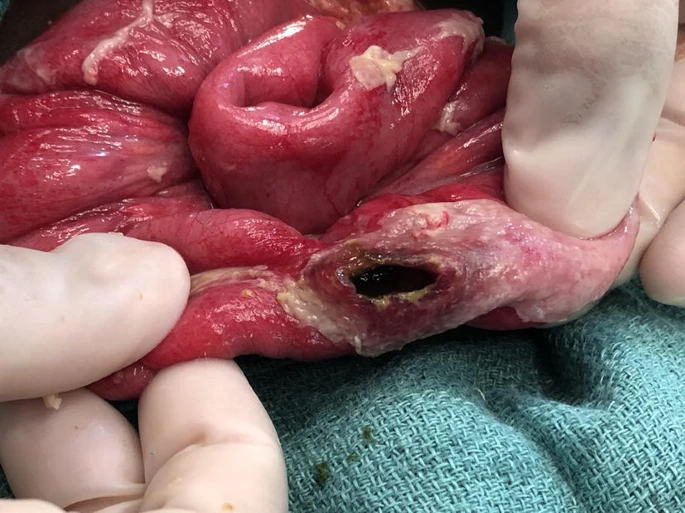One of the most severe complications of typhoid fever is typhoid perforation, a condition where the intestinal wall becomes perforated due to the formation of ulcers. Those who have seen people with intestinal perforation from typhoid fever will not wish it on their worst enemy.
This is because going beyond the cost of treatment and a long hospital stay, it has a high mortality rate. It is not good to prescribe antibiotics for yourself because you may just be contributing to your resistance to antibiotics and at the right time, when the need arises, it may no longer be effective to combat infection.
In this post, I will cover another aspect of complications from typhoid fever that has to do with typhoid perforation. Already, I have covered typhoid fever in a separate post. This post covers more typhoid perforation, while another will cover typhoid bleeding.
Symptoms:
Typhoid perforation often presents with a constellation of symptoms that progressively worsen as the condition advances. Initially, individuals may experience symptoms typical of typhoid fever, such as:
- Fever: A sustained high fever, often exceeding 103°F (39.4°C), is a hallmark symptom of typhoid fever. The fever in this case can be higher than this level when perforation has occurred.
- Headache and Body Aches: Patients may complain of headaches, generalized body aches, and muscle weakness.
- Diarrhea or Constipation: Some individuals may experience diarrhea or constipation, which can alternate.
- Weakness and Fatigue: Profound weakness and fatigue are common due to the body’s efforts to fight the infection. Also, nutrients are no longer appropriately absorbed into the system, making it difficult for the body to remain in a stable state.
- Worsening Abdominal Pain: The abdominal pain becomes severe and localized, often requiring medical attention. Normally, abdominal pain occurs later in typhoid fever; however, in the case of typhoid perforation, it will be worse and cause serious discomfort.
- Distension of the Abdomen: The abdomen may become visibly swollen or distended due to gas accumulation. The abdomen can continue to swell if no surgical intervention is done immediately.
- Nausea and Vomiting: Persistent nausea and vomiting can occur, leading to dehydration. Oftentimes, people with intestinal perforation do not need to eat something through the mouth as it will enter into the abdominal cavity and increase their problems. To correct the loss that is happening as a result of the vomiting, there should an intravenous access to give fluid and nutrients.
- Signs of Shock: In severe cases, patients may exhibit signs of shock, including rapid heartbeat, shallow breathing, and cold, clammy skin. This situation can lead to the death of the person if not well handled. This is where specialist care is highly needed.
What leads to typhoid perforation?
Typhoid perforation occurs due to complications of untreated or inadequately treated typhoid fever. The primary cause is the invasion of Salmonella typhi bacteria into the intestinal mucosa, leading to the formation of ulcers. Without proper treatment, these ulcers can erode through the intestinal wall, resulting in perforation. Factors contributing to the development of typhoid perforation include:
- Delay in Seeking Medical Care: Failure to seek prompt medical attention for typhoid fever increases the risk of complications, including perforation. In developing countries where some people still believe in the efficacy of herbs, such may delay their early coming to the hospital as they will believe in their herbs until it has failed them. People come to the hospital late due to a lack of the financial need to foot bills.
- Inadequate Antibiotic Therapy: Inappropriate or incomplete antibiotic treatment can allow the bacteria to persist and proliferate, exacerbating the infection. This is the problem with self-medication. You may not know the right duration of the drug you are giving yourself. Also, some people have formed the bad habit of not finishing their drugs each time it is given to them. This gives a poor prognosis for their illness and can lead to severe complications.
- Poor Sanitation and Hygiene: Living in environments with inadequate sanitation and hygiene practices increases the likelihood of contracting typhoid fever.
- Contaminated Food and Water: Consumption of food or water contaminated with Salmonella typhi is a common mode of transmission.
How intestinal perforation occurs in typhoid fever:

The pathophysiology of typhoid perforation involves a cascade of events initiated by the invasion of Salmonella typhi bacteria into the intestinal mucosa. Here’s how it unfolds:
- Bacterial Invasion: Salmonella typhi bacteria enter the body through contaminated food or water, primarily targeting the small intestine.
- Multiplication and Ulcer Formation: The bacteria multiply within the intestinal mucosa, leading to the formation of characteristic ulcers.
- Tissue Destruction and Perforation: Without adequate treatment, the ulcers deepen, eroding through the layers of the intestinal wall, eventually causing perforation.
- Peritonitis and Systemic Inflammation: Perforation allows intestinal contents to leak into the abdominal cavity, triggering peritonitis—an inflammatory response of the abdominal lining. Systemic inflammation ensues, further complicating the condition.
Investigations:
A timely and accurate diagnosis is crucial for managing typhoid perforation. This is why any of the following investigations may be requested by your doctor to help him know where your problem is coming from.
- Blood Tests: Blood samples are analyzed for the presence of Salmonella typhi bacteria and markers of infection, such as an elevated white blood cell count and inflammatory markers like C-reactive protein (CRP).
- Stool Culture: A stool sample may be collected to culture the bacteria, aiding in diagnosis.
- Imaging Studies: Imaging tests like abdominal X-rays or CT scans can help visualize intestinal perforations and assess the extent of abdominal involvement.
- Peritoneal Fluid Analysis: If there is suspicion of peritonitis (inflammation of the abdominal lining), fluid may be aspirated from the abdomen for analysis.
Treatment:
The management of typhoid perforation requires a multidisciplinary approach involving medical and surgical interventions. Treatment modalities include:
- Antibiotic Therapy: Prompt initiation of appropriate antibiotics is essential to eradicate the Salmonella typhi infection and prevent further complications. Commonly used antibiotics include fluoroquinolones, cephalosporins, and azithromycin.
- Fluid and Electrolyte Replacement: Intravenous fluids and electrolytes are administered to correct dehydration and maintain electrolyte balance, especially in cases with severe diarrhea and vomiting.
- Surgical Intervention: Surgical intervention is the cornerstone of treatment for typhoid perforation. The primary goal of surgery is to repair the perforation, remove any contaminated material from the abdominal cavity, and prevent further complications such as peritonitis and sepsis. The surgical approach may vary depending on the size and location of the perforation, as well as the patient’s overall condition. In some cases, primary closure of the perforation may be feasible, while larger perforations may require more extensive procedures such as segmental resection and bowel anastomosis. Peritoneal lavage with saline or antimicrobial solutions may be performed to reduce bacterial contamination and inflammation in the abdominal cavity. In cases of multiple perforations or extensive tissue damage, a staged surgical approach may be necessary, with initial surgery focused on source control followed by subsequent procedures for definitive repair and reconstruction.
- Nutritional Support: Adequate nutrition is crucial for supporting the body’s healing process. Enteral or parenteral nutrition may be required in cases where oral intake is compromised.
- Postoperative Care: Close monitoring in the postoperative period is essential to detect and manage complications such as wound infections, intra-abdominal abscesses, and sepsis.
Prognosis of typhoid perforation
The prognosis of typhoid perforation depends on several factors, including the timeliness of diagnosis, the severity of the perforation, the presence of complications, and the patient’s overall health status. Despite advances in medical and surgical management, typhoid perforation remains associated with significant morbidity and mortality, particularly in resource-limited settings.
Early diagnosis and prompt surgical intervention are associated with better outcomes, with mortality rates ranging from 10% to 30% in most series. Delayed presentation, extensive bowel involvement, and the development of complications such as peritonitis, sepsis, or organ failure are associated with higher mortality rates.
Long-term complications of typhoid perforation may include intestinal fistulas, strictures, and recurrent episodes of peritonitis. Patients who survive the acute phase of the illness may require long-term follow-up and monitoring for the development of such complications.
Preventive measures such as improved sanitation, access to clean water, and vaccination against typhoid fever are essential for reducing the incidence of typhoid perforation in endemic regions. Public health efforts aimed at controlling the spread of Salmonella typhi and promoting hygiene practices can help mitigate the burden of this preventable complication.
Conclusion:
Typhoid perforation is a severe complication of typhoid fever that requires prompt recognition and intervention. Understanding the symptoms, diagnostic approaches, causes, pathophysiology, and treatment options for typhoid perforation is essential for healthcare providers and the general public alike. By promoting awareness and implementing effective preventive measures, we can mitigate the burden of this potentially life-threatening condition and improve patient outcomes.
References:
- Crump JA, Luby SP, Mintz ED. The global burden of typhoid fever. Bull World Health Organ. 2004;82(5):346-353.
- Bhutta ZA. Current concepts in the diagnosis and treatment of typhoid fever. BMJ. 2006;333(7558):78-82.
- Siddiqui F, Siddiqui MA. Typhoid fever and its complications. Postgrad Med J. 2006;82(970):704-710.
- Malla BR, Shrestha G, Khanal A, et al. Enteric perforation in typhoid fever: A persisting problem in developing countries. J Infect Dev Ctries. 2010;4(10):663-667.
- Butt U, Usman M, Siddique F, Khan M. Typhoid enteric perforation: risk factors and antibiotic susceptibility pattern of Salmonella typhi in Islamabad, Pakistan. J Pak Med Assoc.




